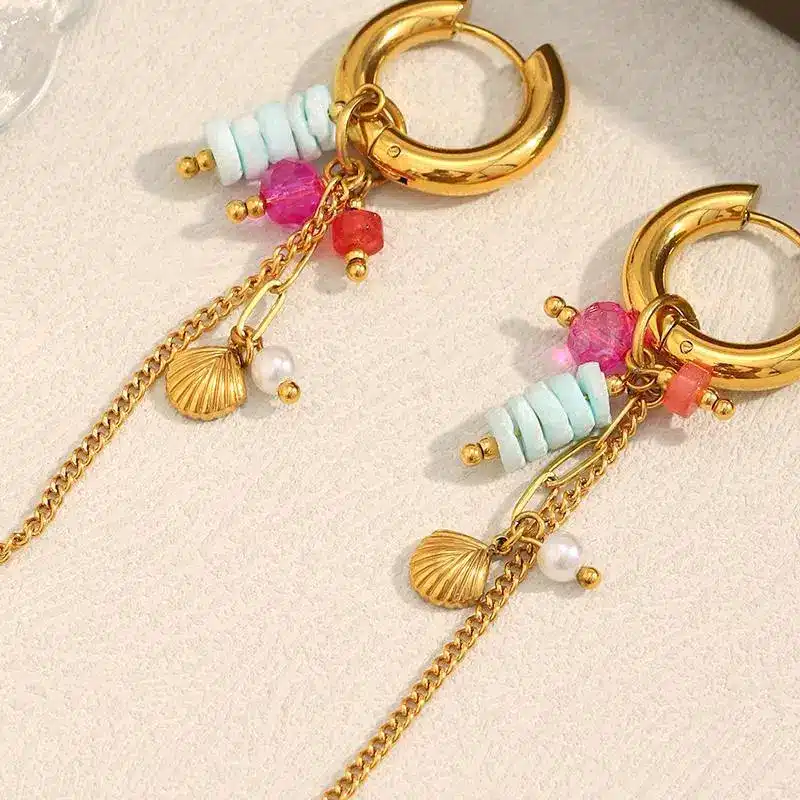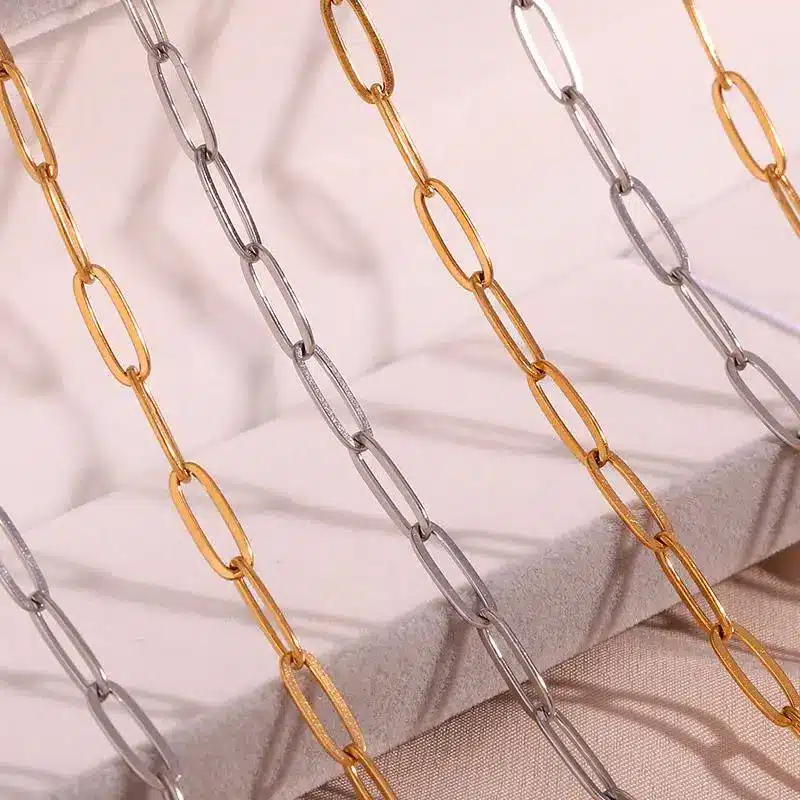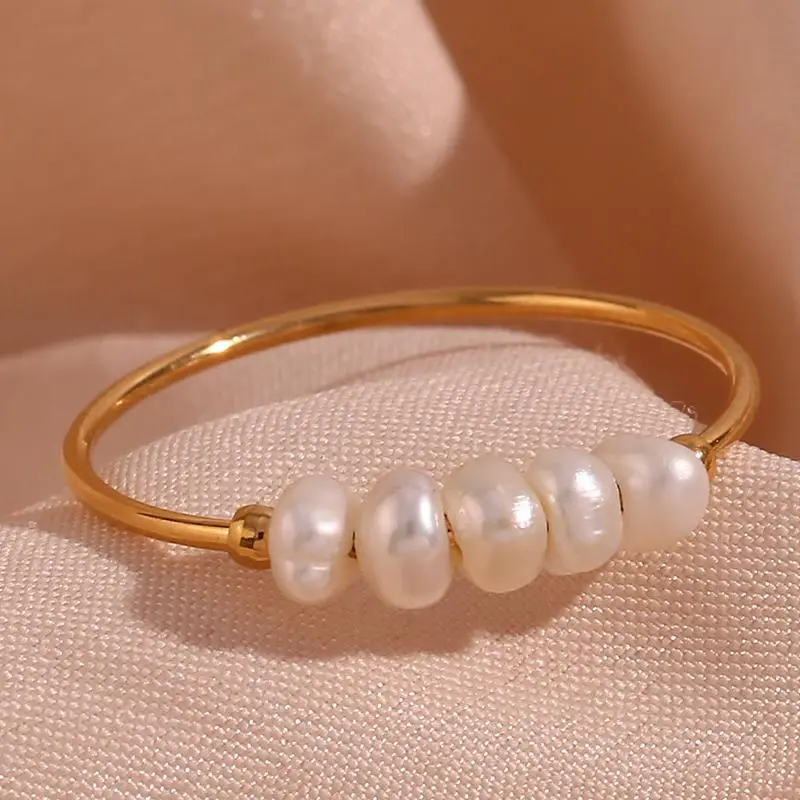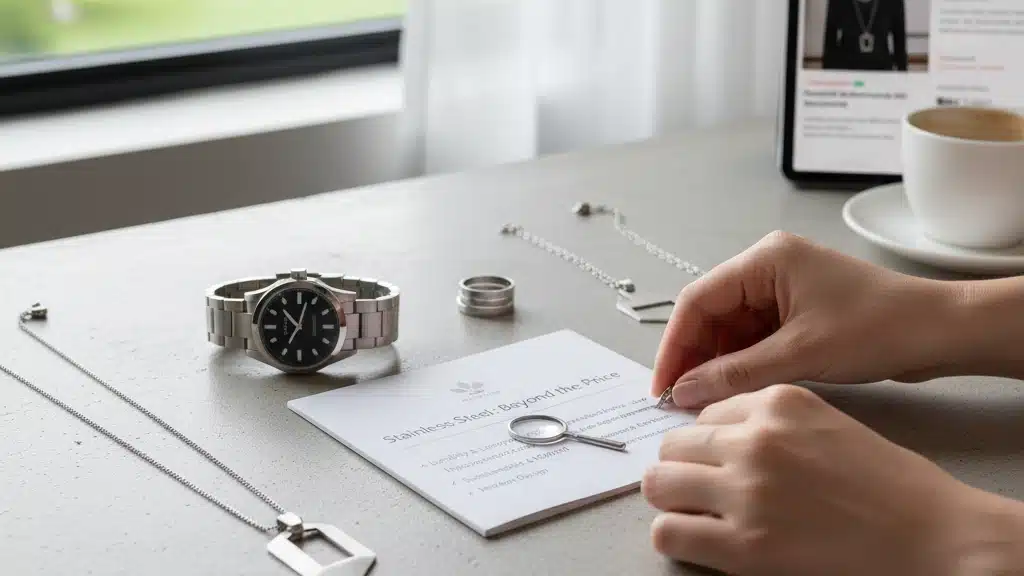Waterproof Jewelry Materials: A Guide for Your Next Vacation

Key Takeaways
- Waterproof jewelry goes a step further and is made to withstand extended water exposure, whereas waterproof jewelry withstands moisture exposure, and water-resistant jewelry merely endures minimal moisture exposure.
- Things like stainless steel, titanium, platinum, solid gold, silicone and rubber are some of the best materials for waterproof jewelry.
- Protective coatings such as PVD and rhodium plating provide water resistance and aesthetic benefits to jewelry yet can necessitate upkeep in the long term.
- Some metals, like silver and low karat alloys, tarnish easily from moisture, so opting for higher quality materials will add jewelry durability.
- Some gemstones are more water resistant than others. Some might require extra care or consideration in creating waterproof jewelry.
- Consistent cleaning, mindful storage and effective post-water care are necessary to keep your waterproof jewelry intact and shimmering.
Waterproof jewelry materials include stainless steel, titanium, platinum, and silicone. These metals and non-metal alternatives don’t rust or dull when worn in water.
A lot of brands utilize stainless steel for its combination of durability and minimal maintenance. Titanium is lightweight and hypoallergenic. Platinum provides a durable, timeless option. Silicone bands are great for everyday wear.
The main body will discuss the advantages and maintenance tips of each material.
What makes jewelry waterproof?
Waterproof jewelry is crafted to endure direct, repeated or extended exposure to water—versus its water-resistant counterparts, which can only handle modest splashes. To be waterproof, jewelry has to prevent water from getting in, avoid rust, tarnish, or degradation, and maintain its appearance and structural integrity.
It’s the perfect combination of materials, clever design, and custom coatings that provides jewelry with this type of protection. Key materials that help make jewelry waterproof include:
- Stainless steel (notably 316L and 304 grades)
- High-karat gold (14k and 18k)
- Tungsten carbide
- Platinum
- Silicone
- Polymer-based resins
- E-coating and PVD-plating (for extra surface protection)
Waterproof vs water-resistant
Waterproof means the jewelry seals out water, even if you wear it in a pool, sea or shower for an extended period. Water-resistant jewelry, on the other hand, only protects against minor moisture, such as rain or perspiration.
For instance, gold-plated or fashion jewelry with base metals may be deemed water-resistant, but they will wear down or tarnish after some exposure. The waterproof vs. Water-resistant jewelry decision is important for swimmers, surfers and active people alike.
Waterproof jewelry can be worn in any environment, but water-resistant pieces require more attention and should not be worn for extended water exposure. Always review the product specifications or manufacturer rating prior to purchasing jewelry if you require consistent water protection.
The science behind it
Waterproof materials repel water because they have tightly bound molecules. Stainless steel and platinum, for instance, prevent water from piercing the surface. Silicone is another instance – its non-porous makeup fights water, assisting it in maintaining its color and form as time goes on.
E-coating and PVD-plating go a long way. These coatings are thin but tough, cloaking the jewelry in a hard layer that prevents water from coming in contact with the base metal. That translates to less chance of rust or tarnish, even when worn daily.
Temperature and pressure changes can stress jewelry, but the best waterproof treasures are designed to weather these swings. Smart design—think rounded edges, waterproof sealed seams, and snug settings—keep water from sneaking in.
Engineering with tight tolerances, applying coatings, and selecting appropriate metals combine to increase waterproof durability.
Why some metals tarnish
Metals such as sterling silver, copper and some lower grade alloys tarnish quickly in water. The primary culprit is that these metals interact with oxygen and moisture to create oxides or sulfides that cloud the surface.
When this occurs, jewelry dulls and may even become brittle. Tarnish can make rings or necklaces appear aged, and sometimes it can rub off on skin or clothes. That’s why most people steer away from sterling silver or low-cost alloys for jewelry that will get wet frequently.
To prevent tarnishing, opt for non-corrosive metals such as stainless steel, platinum, or high-karat gold. Keep jewelry in a dry location and clean it frequently. Coatings such as e-coating or PVD-plating assist, acting as a barrier to water and air.
The best waterproof jewelry materials
These are the best waterproof jewelry materials based on their durability, water resistance, and aesthetics. These materials maintain the sparkle and form after wear. They suit all types of styles and can be worn to any occasion. As you choose a material, consider its water resistance, aesthetics, and convenience.
1. Stainless steel
Stainless steel is incredibly durable and doesn’t scratch or rust easily, even with everyday use. It’s an alloy primarily of iron and carbon, with dozens of grades. That makes it a premier pick for anyone desiring enduring jewelry.
It doesn’t trigger skin issues for most people, so it’s a smart choice for allergy sufferers. Stainless steel is simple to maintain clean, even in moist locations. You can wash it in soap and water, and it stays shiny even after a bunch of wears.
Popular stainless steel items include bracelets, rings, watches and even necklaces. These pieces pull double duty for both minimal and statement looks.
2. Titanium
Titanium is light yet incredibly strong, ideal for women on the go. It won’t rust, even in saltwater or pools—which makes it a great option for swimming or beach days.
Titanium jewelry is available in a variety of finishes–matte, polished or anodized colors. These choices allow you to coordinate it with any outfit. More people pick titanium bands and fine jewelry because it endures and never weighs down.
This is particularly true with wedding rings.
3. Platinum
Platinum is known for its rich color and high shine. It won’t tarnish or oxidize or wear down, so it maintains its appearance for years. Due to its density, platinum is heavy and substantial to wear. It can take a beating without warping.
High-end jewelers utilize platinum for engagement rings and heirloom pieces. Its inherent shine makes stones appear more luminous and transparent — which is why it’s common with diamonds or other stones.
4. Solid gold
Gold is a lot of things, but lower karat gold—such as 14K and 18K—resists water and doesn’t scratch or deteriorate as quickly. It’s ideal for everyday wear — in the shower, at the pool, or while washing your hands.
Gold jewelry suits every style, from traditional to fashion-forward. Gold-filled pieces are less expensive than solid gold, but they still weather water gracefully.
Even gold vermeil, with its hefty gold coat, and rhodium are able to combat water.
5. Silicone and rubber
Silicone and rubber are soft, bendy and comfortable to wear. They don’t get wrecked by water, hence people are wearing them for sports, swimming or hiking.
They’re available in a ton of vibrant colors and whimsical shapes. They perform best for casual jewelry, such as bands and necklaces.
For those seeking effortless, waterproof jewelry, these are top contenders.
How coatings create resilience
That’s what coatings are all about waterproof jewelry. They act as a barrier preventing moisture, perspiration, and other airborne contaminants from degrading the metal. This protective barrier slows rust, stains, and dull spots. A lot of these coatings assist in arresting chemical reactions, so jewelry remains luminous for longer.
Certain coatings, such as PVD and rhodium, can enhance the appearance of jewelry by imparting shine or color. When buyers choose coated jewelry, they receive pieces that are more durable and appear more luminous, even with wear every day.
PVD coating
PVD, or Physical Vapor Deposition, is when an ultra-thin layer of metal is applied to the jewelry in a vacuum. This coating clings resistently to the underlying metal, rendering the surface incredibly resilient and resistant to water, sweat and chemicals.
PVD coatings employ high-strength alloys and even nanotechnology, with miniscule particles filling any crevices so water can’t penetrate. This makes PVD a favorite for waterproof jewelry.
|
Coating Type |
Wear Resistance |
Color Range |
Shine |
Thickness |
Longevity |
|---|---|---|---|---|---|
|
PVD |
High |
Wide |
High |
Thin |
Long |
|
Traditional |
Low |
Limited |
Low |
Thick |
Short |
|
Polymer-based |
Moderate |
Moderate |
Matte |
Medium |
Moderate |
PVD jewelry can be offered in gold, silver, black, rose, and even bold colors like blue or green. This variety aids brands in providing more than just the typical designs. PVD pieces typically retain their color and finish for years, as long as the coating remains intact.
Care is easy—don’t scrub aggressively and use hard chemicals, and check the coating from time to time.
Rhodium plating
Rhodium plating is primarily used to make jewelry shinier and more durable. It’s typical on silver and white gold, imparting them with a mirror-like brilliancy that is difficult to achieve with bare metal.
This coating decreases tarnish. Silver is prone to black marks or yellowing, rhodium keeps the surface clean for longer. Still, rhodium is not a permanent answer. It wears down with wear, so re-coating every few years maintains the luster and defense.
For the rest of you who want a shiny, luminous finish, rhodium-plated pieces are a strong option, particularly if you’re a fan of cool-toned metals.
The importance of coatings
Waterproof jewelry is as strong as its coating. Coatings that adhere well to the substrate metal and are rated to standards such as IP Code or ISO 22810 will have extended longevity. Some coatings are 10x stronger than bare metal so you’ve got less stress about color fading or stains.
A thick coating is not the conclusion. Inspecting your jewelry for chips or thin spots is essential. Damage can let water in, so regular maintenance keeps the armor striding.
Are any gemstones waterproof?

Not every gemstone can withstand water. Some are hardy and wear like a charm, while others will fade or even disintegrate if wet too long. The bottom line is that gemstones are water resistant based on their composition, hardness, and occasionally treatment.
Gemstones are very different in their behavior with water. Here’s a quick look at how some common gems handle water:
|
Gemstone |
Mohs Hardness |
Water Resistance |
Notes |
|---|---|---|---|
|
Diamond |
10 |
High |
Safe in water, rare damage |
|
Sapphire |
9 |
High |
Withstands water, stays bright |
|
Ruby |
9 |
High |
Strong against water |
|
Quartz |
7 |
Moderate |
Usually safe, but avoid long soak |
|
Opal |
5.5–6.5 |
Low |
Can crack or lose color when wet |
|
Pearl |
2.5–4.5 |
Very Low |
Loses lustre, softens with water |
|
Turquoise |
5–6 |
Low |
Water absorbent, color change |
|
Emerald |
7.5–8 |
Moderate |
Treated stones can react to water |
|
Amber |
2–2.5 |
Very Low |
Soft, will degrade in water |
All gems with a Mohs value under 5, such as amber and pearl, must remain dry. Water can weaken them or cause them to break down. Pearls are even more sensitive—they can become dull and are easily damaged if left in water.
Opals, turquoise and the like can absorb water, which can result in cracks or color staining. Even harder stones, such as quartz and emerald, can have issues if they are enhanced or have fractures that allow moisture penetration.
Special treatments can assist some gems to manage water better. For instance, certain stones receive a waterproof layer, such as PVD, which creates an ultra-thin, durable barrier. This can help keep water out and make jewelry last longer.
Resin is used, particularly for pieces with tiny trinkets or inclusions within. It creates a seal to prevent water from penetrating to the internal components.
For waterproof jewelry designs, a few stones wear better than others. Diamonds, sapphires and rubies, for example, are hard and don’t absorb water. These are frequently selected for rings or bracelets that get wet frequently.
Quartz is popular, but less hardy than the rest, so keep water exposure short. On settings or pieces where water is a concern, using high-karat gold (14k, 18k), platinum, or stainless steel aids, because these metals don’t rust.
Silicone and resin provide even more choices for waterproof styles and are utilized in contemporary, flexible designs.
Essential jewelry care tips

Waterproof jewelry can take more than most, but it still needs a little love to shine. Rouge, rubbers, even strong metals can dull without easy maintenance. Safe cleaning and smart storage preserve finishes, prevent damage and keep jewelry looking bright all year long.
After the beach
Rinse off jewelry with fresh water after swimming in salt water or playing in the sand. Salt and sand can abrade coatings, particularly on plated or vermeil pieces. This prevents buildup that can dull shine or scratch surfaces.
Dry jewelry well with a soft, clean cloth. Any moisture that remains on metal or stones will cause spots, tarnishing, or even loosened settings over time. Softly towel dry each item, being sure to cover clasps and crevices.
A soft cloth is perfect for gentle cleaning, particularly of solid gold, stainless steel, or waterproof-coated pieces. Wipe with a soft, non-abrasive cloth to keep the finish bright. Inspect for loose stones or bent prongs following your outings. Repairs done early prevent lost stones or additional damage.
Poolside precautions
Discard jewelry prior to swimming in chlorine pools. Chlorinated water can react with metals and coatings, resulting in dullness or even discoloration, particularly with vermeil or plated pieces. Solid gold is less impacted, but frequent exposure can still erode some alloys.
Lotions, oils and sunscreen can cling to chains and settings, leaving them appearing drab or collecting grime. Try to wear jewelry after you apply any skin lotions. If jewelry does come in contact with pool water, immediately rinse with fresh water, then dry thoroughly.
A few pieces of waterproof jewelry are specifically designed for pool wear, usually with abrasive resistant finishes or solid metals. These are less likely to react with chemicals. Even so, small rinses and soft cloth scrubs can maintain their prime.
Long-term storage
Keep jewelry in a cool dry place to prevent moisture accumulation and tarnishing. Moist air accelerates rust, even on hard metals like stainless steel.
Store it in padded boxes or soft pouches to prevent knocks and scratches. Store chains, rings and earrings separately to prevent tangling or scuffs, particularly when dealing with mixed metals or coated pieces.
Examine stored jewelry every few months. Check for loose stones, worn clasps or moisture. Early fixes prevent small issues from becoming large, and simple, regular cleaning—such as a light soak or soft polish—will extend the life of jewelry and keep it radiant.
Essential care checklist
- Rinse after beach or pool, dry well
- Store in cool, dry place, use padding
- Avoid lotions, oils, and harsh chemicals
- Inspect for damage or loose parts
- Polish with soft cloth, mild cleaner every few weeks
My take on vacation accessories

Selecting the appropriate jewelry for vacation boils down to selecting pieces that translate in multiple situations and can withstand water, sweat and outdoor adventures. Waterproof bling is a clever selection for summer vacations or wherever you might swim, sweat or get caught in the rain. They hold up well, so you can swim, hike or simply stroll around town.
Stainless steel, solid gold (14K and up), and gold-filled pieces maintain their shine and shape no matter how many all-day beach or pool excursions you take. Rhodium-plated jewelry is a great choice – it won’t tarnish or fade even in hot, sweaty weather! Others opt for gold vermeil for its combination of aesthetics and durability. For lazy days, water-resistant jewelry could cut it — but it may not hold up as long if you frequently swim or engage in water sports.
If you’re packing adaptable jewelry, you need less and everything you bring serves a purpose. Bold colored layered necklaces can add interest to simple outfits and make it effortless to transition from a stroll on the beach to dinner out. Waterproof rings, earrings and bracelets can maintain their style throughout an entire trip, regardless of the itinerary.
This reduces the amount of extra stuff you have to pack or fret about destroying from saltwater or sweat. A lot of travelers desire both fashion and practicality. No need to sacrifice one for the other. Contemporary waterproof jewelry runs the gamut from understated to statement so it suits most style sensibilities.
Smart design means these babies can blend in at a pool party, on a hike or at a fancy dinner. Maintaining clean jewelry is a breeze—simply exfoliate with a soft cloth to remove dust or salt, and it will endure longer.
Tips for choosing waterproof jewelry for travel:
- Choose stainless steel, solid gold (14K+) or gold-filled for optimal water resistance.
- Search for rhodium plating or gold vermeil in sweat-bathed environments.
- Pick items that work with both casual and more dressed up outfits.
- Don’t buy jewelry that says ‘water-resistant’ for intense or daily water exposure.
- Wipe clean with a soft cloth on a regular basis to keep it fresh and shiny.
- Pack a dinky little pouch to protect jewelry while traveling.
Conclusion
Waterproof jewelry that’s up to daily wear, beach days, and gym sweat. Metals such as stainless and titanium fare well. Gold and platinum stand the test of time in wet locations. Some coatings add additional durability, but nothing protects every piece indefinitely. Since most gems are not fans of water, it pays to look before you leap. Basic actions such as drying pieces or storing them in a pouch maintain their appearance. A lot of us want tough, cool looking pieces for travel or chaotic days. Waterproof jewelry provides that peace of mind. Want to learn what brands or styles work best for you? Connect or post your selections. Let’s exchange advice and anecdotes.
Frequently Asked Questions
What materials are best for waterproof jewelry?
Stainless steel, titanium, and platinum are top choices for waterproof jewelry. These metals do not rust and won’t tarnish, even with regular water exposure.
Can gold jewelry be waterproof?
Solid gold is very water-resistant, gold-plated jewelry is not. Water eventually erodes the plating, revealing the base metal.
Are gemstones safe to wear in water?
Not every gem sparkles underwater! Diamonds, sapphires all deal with water beautifully, but porous stones such as opal and turquoise are susceptible to water damage.
Do protective coatings make jewelry waterproof?
Of course, rhodium or clear resin protective coatings provide a layer of water resistance. Coatings can chip and require continual reapplication to remain effective.
How do I care for waterproof jewelry?
So if like me, you are a swimmer, be sure to RINSE your jewelry with clean water after swimming and dry with a soft cloth. Routine cleaning keeps the shine and avoids accumulation — even in waterproof materials.
Is silicone jewelry waterproof?
Yes, silicone is 100% waterproof. It doesn’t rust or tarnish or soak up water, so it’s perfect for sports and the outdoors.
Can I wear waterproof jewelry in the ocean?
Waterproof jewelry such as stainless steel and titanium can easily withstand ocean water. Always wash it with fresh water after being exposed to salt as it can cause dirt and grime buildup that dulls the shine.
Related Posts

Understanding Wholesale Jewelry Pricing and How It Works
Understanding Wholesale Jewelry Pricing and How It Works When people see a ring that costs $6 wholesale and retails for $59, they often

The Art of Shine in Jewelry Polishing and Plating Techniques
Discover how polishing and plating transform modern jewelry with expert techniques for lasting shine and elegant finishes.

Τι Νοιάζει Πραγματικά τους Αγοραστές Ανοξείδωτου Κοσμήματος Εκτός από την Τιμή
Τι πραγματικά νοιάζει τους αγοραστές ατσάλινων κοσμημάτων πέρα από την τιμή ανθεκτικότητα υποαλλεργικά υλικά και μοντέρνο στυλ.
